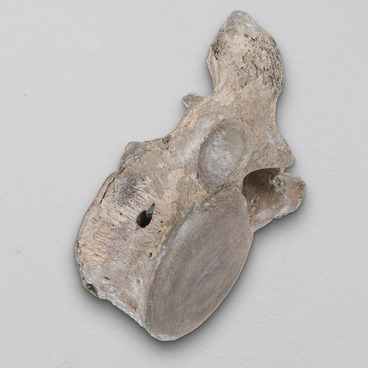The skulls of mammoths, like all elephants, differ sharply from the skulls of other land animals and, since ancient times, have elicited surprise from the people that find them. The reason is both their size and special structure. For example, the nasal cavity mammoths had was located in the middle of a massive forehead, and was similar to an eye socket. The ancient Greeks attributed the bones of extinct elephants that they found to various mythical characters, including the one-eyed giant cyclops.
This exhibit was found on the territory of a unique paleontological and archaeological site in the valley of the Ob River to the west of Khanty-Mansiysk, near village of Lugovskoye. This place where the bones of ancient animals accumulated was well-known to the inhabitants of the surrounding villages. Since 1998, employees of the Department of Paleontology of the ‘Museum of Nature and Man’ have been conducting annual field research at Lugovskoye. In total, more than 6,500 mammoth bones have been found at Lugovskoye, including this skull fragment.
This example can be used to study some of the features inherent in the structure of elephants’ skulls. Between the outer shell of the skull and the cerebral capsule, where the brain itself was directly located, there is a space with a cellular structure, like a honeycomb. This porosity made the skull lighter, but relatively strong. At the same time, the cerebral capsule and the brain located inside it were reliably isolated from external temperature influences by the same hollow “honeycombs”: they were protected from the cold in the winter and from the heat in the summer.
The actual structure of the woolly mammoth’s brain itself was partially studied using another exhibit: the Yuk mammoth. That was found in 2011 on the shores of the Laptev Sea in Yakutia. They found the mammoth’s body without any of its internal organs, but by virtue of the permafrost some fragments of the hide with its fur coat, and of the brain in the skull, were preserved. An international team of scientists found out that part of the mammoth’s DNA was still active. It is not possible to clone a mammoth using available technologies and specimens, but researchers plan to find out some of the mechanisms that governed the development and extinction of woolly mammoths as a species.
This exhibit was found on the territory of a unique paleontological and archaeological site in the valley of the Ob River to the west of Khanty-Mansiysk, near village of Lugovskoye. This place where the bones of ancient animals accumulated was well-known to the inhabitants of the surrounding villages. Since 1998, employees of the Department of Paleontology of the ‘Museum of Nature and Man’ have been conducting annual field research at Lugovskoye. In total, more than 6,500 mammoth bones have been found at Lugovskoye, including this skull fragment.
This example can be used to study some of the features inherent in the structure of elephants’ skulls. Between the outer shell of the skull and the cerebral capsule, where the brain itself was directly located, there is a space with a cellular structure, like a honeycomb. This porosity made the skull lighter, but relatively strong. At the same time, the cerebral capsule and the brain located inside it were reliably isolated from external temperature influences by the same hollow “honeycombs”: they were protected from the cold in the winter and from the heat in the summer.
The actual structure of the woolly mammoth’s brain itself was partially studied using another exhibit: the Yuk mammoth. That was found in 2011 on the shores of the Laptev Sea in Yakutia. They found the mammoth’s body without any of its internal organs, but by virtue of the permafrost some fragments of the hide with its fur coat, and of the brain in the skull, were preserved. An international team of scientists found out that part of the mammoth’s DNA was still active. It is not possible to clone a mammoth using available technologies and specimens, but researchers plan to find out some of the mechanisms that governed the development and extinction of woolly mammoths as a species.



